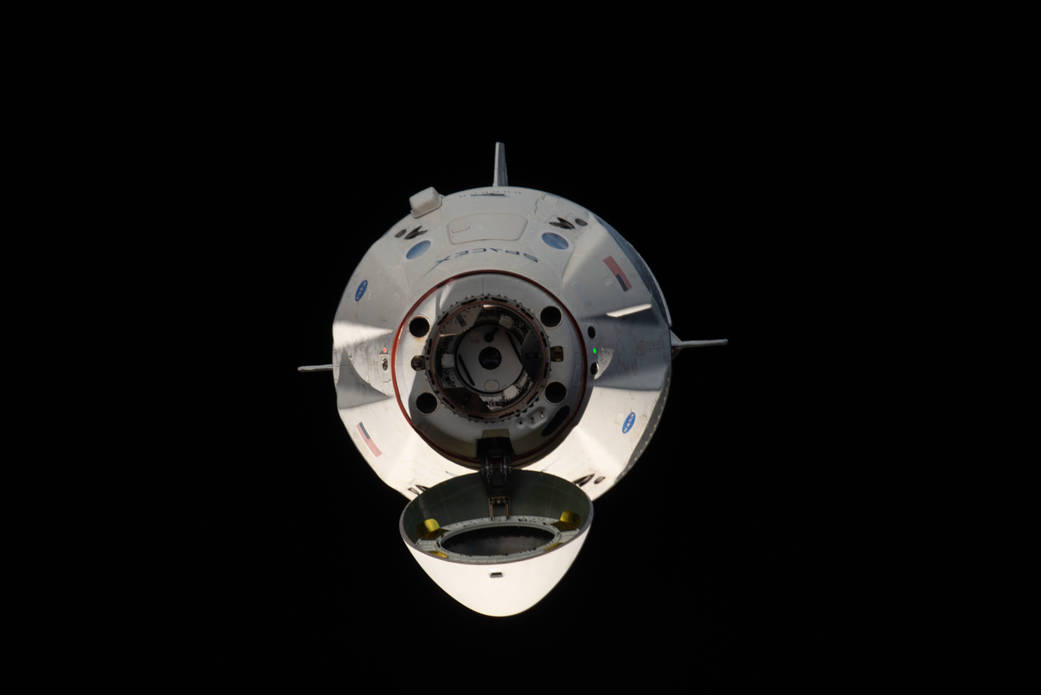
SpaceX's new astronaut taxi will return to Earth tomorrow morning (March 8), but a safe return is no slam dunk.
Indeed, the fast and fiery descent through our planet's atmosphere may be the most difficult part of Demo-1, the Crew Dragon capsule's maiden mission to the International Space Station (ISS), according to SpaceX founder and CEO Elon Musk.
"I see hypersonic re-entry as probably my greatest concern," Musk said on Saturday morning (March 2) a few hours after Crew Dragon launched atop a SpaceX Falcon 9 rocket, kicking off the uncrewed Demo-1 shakeout flight.
Related: SpaceX Dragon Crew Demo-1 Test Flight: Full Coverage
He mentioned Crew Dragon’s parachute system and backshell. Both are relatively unproven; they're quite different from the versions employed by the cargo variant of Dragon, which has flown 16 robotic resupply runs to the ISS for NASA.
For example, the cargo Dragon's backshell is a smooth, conic shape. But Crew Dragon's is asymmetrical, because it has to accommodate the eight SuperDraco escape engines that would get the capsule out of harm's way in the event of a launch emergency.
"That could potentially cause a roll instability on re-entry," Musk said. “I think it’s unlikely; we’ve run simulations a thousand times. But this is a possibility."
Get the Space.com Newsletter
Breaking space news, the latest updates on rocket launches, skywatching events and more!
Similarly, he added, "Will the parachutes deploy correctly? Will the system guide Dragon 2 to the right location and splash down safely?”
That location is the Atlantic Ocean, not far off the Florida coast. The cargo Dragon comes down in the Pacific, but SpaceX wants to get the crewed variant back to its processing facilities on Florida's Space Coast quickly, company representatives have said.
Crew Dragon is scheduled to leave the ISS on Friday at 2:31 a.m. EST (0731 GMT) and splash down around 8:45 a.m. EST (1345 GMT). You can watch these events live here on Space.com when the time comes, courtesy of NASA TV.
SpaceX has been developing Crew Dragon under a $2.6 billion NASA contract the company signed in 2014 — a different deal than the one structuring the cargo Dragon's resupply runs. Boeing also signed a NASA commercial-crew contract, getting $4.2 billion to build and fly a capsule called the CST-100 Starliner.
Crewed flight could come soon for both of these spacecraft. SpaceX plans to launch two astronauts to the ISS this July on a test flight called Demo-2, provided Demo-1 ends well and a subsequent uncrewed "abort test" putting those SuperDracos into action goes as planned.
Starliner could launch on its version of Demo-1 as early as next month and fly a crewed demonstration mission to the ISS by August, Boeing representatives have said.
Editor's note: You can watch SpaceX's Crew Dragon Demo-1 on Space.com, courtesy of NASA TV. Today, March 7, NASA will webcast the hatch closing of Crew Dragon at 12:15 p.m. EST (1715 GMT). On Friday, live coverage begins at 2 a.m. EST (0700 GMT) for undocking and Earth return operations. Splashdown is scheduled for 8:45 a.m EST (1345 GMT).
- SpaceX's Crew Dragon Demo-1 Test Flight in Pictures
- In Photos: Astronauts Bond with Little Earth 'Celestial Buddy'
- The Latest News on SpaceX, Crew Dragon and More
Mike Wall's book about the search for alien life, "Out There" (Grand Central Publishing, 2018; illustrated by Karl Tate) is out now. Follow him on Twitter @michaeldwall. Follow us on Twitter @Spacedotcom or Facebook.
Join our Space Forums to keep talking space on the latest missions, night sky and more! And if you have a news tip, correction or comment, let us know at: community@space.com.

Michael Wall is a Senior Space Writer with Space.com and joined the team in 2010. He primarily covers exoplanets, spaceflight and military space, but has been known to dabble in the space art beat. His book about the search for alien life, "Out There," was published on Nov. 13, 2018. Before becoming a science writer, Michael worked as a herpetologist and wildlife biologist. He has a Ph.D. in evolutionary biology from the University of Sydney, Australia, a bachelor's degree from the University of Arizona, and a graduate certificate in science writing from the University of California, Santa Cruz. To find out what his latest project is, you can follow Michael on Twitter.









